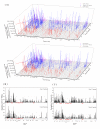Human immunodeficiency virus type 1 specific cytotoxic T lymphocyte responses in Chinese infected with HIV-1 B'/C Recombinant (CRF07_BC)
- PMID: 17727734
- PMCID: PMC2018724
- DOI: 10.1186/1742-4690-4-62
Human immunodeficiency virus type 1 specific cytotoxic T lymphocyte responses in Chinese infected with HIV-1 B'/C Recombinant (CRF07_BC)
Abstract
Background: The characterization of HIV-1-specific T cell responses in people infected with locally circulating HIV-1 strain will facilitate the development of HIV-1 vaccine. Sixty intravenous drug users infected with HIV-1 circulating recombinant form 07_BC (CRF07_BC), which has been spreading rapidly in western China from north to south, were recruited from Xinjiang, China to assess the HIV-1-specific T cell responses at single peptide level with overlapping peptides (OLP) covering the whole concensus clades B and C proteome.
Results: The median of the total magnitude and total number of OLPs recognized by CTL responses were 10925 SFC/million PBMC and 25 OLPs, respectively, when tested by clade C peptides, which was significantly higher than when tested by clade B peptides. The immunodominant regions, which cover 14% (58/413) of the HIV-1 proteome, are widely distributed throughout the HIV-1 proteome except in Tat, Vpu and Pol-PR, with Gag, Pol-RT, Pol-Int and Nef being most frequently targeted. The subdominant epitopes are mostly located in p24, Nef, integrase, Vpr and Vif. Of the responses directed to clade C OLPs, 61.75% (972/1574) can be observed when tested with corresponding clade B OLPs. However, Pol-PR and Vpu tend to be targeted in the clade B sequence rather than the clade C sequence, which is in line with the recombinant pattern of CRF07_BC. Stronger and broader CTL responses in subjects with CD4 cell counts ranging from 200 to 400/mm3 were observed when compared to those with less than 200/mm3 or more than 400/mm3, though there have been no significant correlations identified between the accumulative CTL responses or overall breadth and CD4 cell count or plasma viral load.
Conclusion: This is the first study conducted to comprehensively address T cell responses in Chinese subjects infected with HIV-1 CRF07_BC in which subtle differences in cross-reactivity were observed, though similar patterns of overall immune responses were demonstrated with clade B infected populations. The immunodominant regions identified in this population can facilitate future HIV-1 vaccine development in China.
Figures




Similar articles
-
Differential narrow focusing of immunodominant human immunodeficiency virus gag-specific cytotoxic T-lymphocyte responses in infected African and caucasoid adults and children.J Virol. 2000 Jun;74(12):5679-90. doi: 10.1128/jvi.74.12.5679-5690.2000. J Virol. 2000. PMID: 10823876 Free PMC article.
-
Cytolytic T lymphocytes (CTLs) from HIV-1 subtype C-infected Indian patients recognize CTL epitopes from a conserved immunodominant region of HIV-1 Gag and Nef.J Infect Dis. 2005 Sep 1;192(5):749-59. doi: 10.1086/432547. Epub 2005 Jul 27. J Infect Dis. 2005. PMID: 16088824
-
Cross-reactions between the cytotoxic T-lymphocyte responses of human immunodeficiency virus-infected African and European patients.J Virol. 1998 May;72(5):3547-53. doi: 10.1128/JVI.72.5.3547-3553.1998. J Virol. 1998. PMID: 9557634 Free PMC article.
-
Preferential CTL targeting of Gag is associated with relative viral control in long-term surviving HIV-1 infected former plasma donors from China.Cell Res. 2012 May;22(5):903-14. doi: 10.1038/cr.2012.19. Epub 2012 Jan 31. Cell Res. 2012. PMID: 22290423 Free PMC article.
-
Identification of highly conserved and broadly cross-reactive HIV type 1 cytotoxic T lymphocyte epitopes as candidate immunogens for inclusion in Mycobacterium bovis BCG-vectored HIV vaccines.AIDS Res Hum Retroviruses. 2000 Sep 20;16(14):1433-43. doi: 10.1089/08892220050140982. AIDS Res Hum Retroviruses. 2000. PMID: 11018863 Review.
Cited by
-
Epitope mapping of HIV-specific CD8+ T cells in a cohort dominated by clade A1 infection.PLoS One. 2009 Sep 11;4(9):e6965. doi: 10.1371/journal.pone.0006965. PLoS One. 2009. PMID: 19750221 Free PMC article.
-
Profiling the neutralizing antibody response in chronically HIV-1 CRF07_BC-infected intravenous drug users naïve to antiretroviral therapy.Sci Rep. 2017 Apr 7;7:46308. doi: 10.1038/srep46308. Sci Rep. 2017. PMID: 28387330 Free PMC article.
-
Magnitude, breadth, and functional profile of T-cell responses during human immunodeficiency virus primary infection with B and BF viral variants.J Virol. 2008 Mar;82(6):2853-66. doi: 10.1128/JVI.02260-07. Epub 2008 Jan 9. J Virol. 2008. PMID: 18184702 Free PMC article.
-
APOBEC3G-induced hypermutation of human immunodeficiency virus type-1 is typically a discrete "all or nothing" phenomenon.PLoS Genet. 2012;8(3):e1002550. doi: 10.1371/journal.pgen.1002550. Epub 2012 Mar 22. PLoS Genet. 2012. PMID: 22457633 Free PMC article.
-
Possible footprints of APOBEC3F and/or other APOBEC3 deaminases, but not APOBEC3G, on HIV-1 from patients with acute/early and chronic infections.J Virol. 2014 Nov;88(21):12882-94. doi: 10.1128/JVI.01460-14. Epub 2014 Aug 27. J Virol. 2014. PMID: 25165112 Free PMC article.
References
-
- Feeney ME, Tang Y, Roosevelt KA, Leslie AJ, McIntosh K, Karthas N, Walker BD, Goulder PJ. Immune escape precedes breakthrough human immunodeficiency virus type 1 viremia and broadening of the cytotoxic T-lymphocyte response in an HLA-B27-positive long-term-nonprogressing child. J Virol. 2004;78:8927–8930. doi: 10.1128/JVI.78.16.8927-8930.2004. - DOI - PMC - PubMed
-
- Borrow P, Lewicki H, Wei X, Horwitz MS, Peffer N, Meyers H, Nelson JA, Gairin JE, Hahn BH, Oldstone MB, Shaw GM. Antiviral pressure exerted by HIV-1-specific cytotoxic T lymphocytes (CTLs) during primary infection demonstrated by rapid selection of CTL escape virus. Nat Med. 1997;3:205–211. doi: 10.1038/nm0297-205. - DOI - PubMed
-
- Betts MR, Nason MC, West SM, De Rosa SC, Migueles SA, Abraham J, Lederman MM, Benito JM, Goepfert PA, Connors M, Roederer M, Koup RA. HIV nonprogressors preferentially maintain highly functional HIV-specific CD8+ T cells. Blood. 2006;107:4781–4789. doi: 10.1182/blood-2005-12-4818. - DOI - PMC - PubMed
Publication types
MeSH terms
Substances
Grants and funding
LinkOut - more resources
Full Text Sources
Medical
Research Materials

